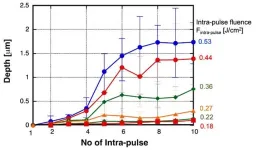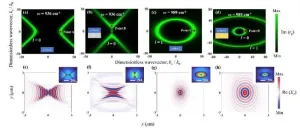Detroit researchers receive Department of Defense grant to assist in discovering new treatments for ovarian cancer
2024-07-08
(Press-News.org) DETROIT — Gen Sheng Wu, Ph.D., professor of oncology in the Wayne State University School of Medicine and the Barbara Ann Karmanos Cancer Institute, recently received a grant from the U.S. Department of Defense’s Congressionally Directed Medical Research Programs.
This four-year, $924,000 grant will benefit Wu’s study, “Targeting Dual-Specificity Phosphatase 1 in Platinum Resistance in Ovarian Cancer,” which aims to discover improved treatments for ovarian cancer.
“Ovarian cancer is one of the deadliest diseases,” said Wu. “It’s difficult to diagnose early and most cases are only found in the late stages. The late stage survival rate is approximately 30%. After surgery, chemotherapy is the other primary treatment; however, patients develop a resistance to this treatment very quickly. It’s a major problem with ovarian cancer and it’s our major challenge in the field.”
The overarching challenge that this research will address is the elimination of drug-resistant ovarian cancer cells using new treatment regimens. Specifically, Wu and his research team have identified a resistance mechanism that involves a protein called dual-specificity phosphatase 1 (DUSP1).
Wu believes this could be an important step in addressing ovarian cancer because it has the potential to improve the efficacy of platinum-based therapies. Platinum-based therapies are the standard first-line chemotherapy for most patients with ovarian cancer. However, almost all patients receiving platinum eventually relapse and die from metastatic disease, mainly due to primary and acquired resistance to the treatment.
“With this grant, we will follow up findings that phosphatases can remove the phosphate group and thus shut down MAPK signaling,” said Wu. “Based on this mechanism, we are studying how this reaction works and how implementing it may increase survival and remission rates.”
“Ovarian cancer is the fifth leading cause of cancer-related deaths among women, and this important funding will help Dr. Wu and his research team to help address this critical challenge,” said Ezemenari Obasi, Ph.D., vice president for research at Wayne State University. “Dr. Wu’s work has the potential to make a lifesaving difference for patients in our community and beyond.”
The award number for this Department of Defense Ovarian Cancer Research Program grant is HT9425-24-1-0694.
# # #
About Wayne State University
Wayne State University is one of the nation’s pre-eminent public research universities in an urban setting. Through its multidisciplinary approach to research and education, and its ongoing collaboration with government, industry and other institutions, the university seeks to enhance economic growth and improve the quality of life in the city of Detroit, state of Michigan and throughout the world. For more information about research at Wayne State University, visit research.wayne.edu.
Wayne State University’s research efforts are dedicated to a prosperity agenda that betters the lives of our students, supports our faculty in pushing the boundaries of knowledge and innovation further, and strengthens the bonds that interconnect Wayne State and our community. To learn more about Wayne State University’s prosperity agenda, visit president.wayne.edu/prosperity-agenda.
END
ELSE PRESS RELEASES FROM THIS DATE:
2024-07-08
Embargoed for release until 5:00 p.m. ET on Monday 8 July 2024
Annals of Internal Medicine Tip Sheet
@Annalsofim
Below please find summaries of new articles that will be published in the next issue of Annals of Internal Medicine. The summaries are not intended to substitute for the full articles as a source of information. This information is under strict embargo and by taking it into possession, media representatives are committing to the terms of ...
2024-07-08
Scientists at the University of Florida have identified a novel compound aimed at improving the treatment of opioid overdoses, which claimed the lives of more than 81,000 Americans last year.
The discovery could combat the devastating epidemic of opioid-related deaths, driven predominantly by the proliferation of fentanyl. The highly potent synthetic opioid is a pain reliever and among the nation’s most abused substances.
“Fentanyl is driving the need to find better treatments for opioid overdoses,” said Jay McLaughlin, Ph.D., a professor of pharmacodynamics in the UF College of Pharmacy. “Every opioid death is preventable, highlighting ...
2024-07-08
WINSTON-SALEM, N.C. – July 8, 2024 – Researchers at Wake Forest University School of Medicine have been awarded a five-year, $27 million grant from the National Institute on Aging (NIA), part of the National Institutes of Health (NIH), to renew funding for MESA-MIND, an ancillary study to the Multi-Ethnic Study of Atherosclerosis (MESA).
In 2018, researchers at Wake Forest University School of Medicine received more than $18 million from the NIA to launch MESA-MIND to study the connections between heart health and brain health.
“In MESA-MIND, we are studying how heart health contributes to brain health in diverse groups of people,” said Timothy Hughes, Ph.D., ...
2024-07-08
As a leader in innovative health solutions, George Mason University’s College of Public Health received a National Institutes of Health (NIH) AIM-AHEAD program grant to pilot an artificial intelligence (AI) chatbot for Black and African Americans with depression. Health Informatics Professor Farrokh Alemi will enhance his first-of-its-kind, evidence-based artificial intelligence tool to address the medication needs of African Americans with depression.
The existing AI tool recommends antidepressants for 16,775 general-population patient subgroups, each representing a unique combination of medical history. For each of ...
2024-07-08
The latest Annual Meeting convened by the Resource Centers for Minority Aging Research (RCMAR) National Coordinating Center, held in Arlington, Virginia, from June 26 to 28, centered on the theme of transforming diverse aging research through inspiring and mentoring scientists.
Current and former RCMAR scientists presented research findings from completed pilot studies and progress updates for ongoing research. The meeting included several professional development sessions for the scientists and members of RCMAR ...
2024-07-08
COLUMBUS, Ohio – While distress is well-documented in patients with sickle cell disease, sources of distress and how patients manage distress have not been well explored.
“Our study found that the most profound source of distress for patient with sickle cell disease in a home visit program was anticipating and going to acute care centers to manage their acute pain,” said senior study author Maryanna Klatt, PhD, director of the Center for Integrative Health at The Ohio State University Wexner Medical Center.
Study findings are published ...
2024-07-08
A new publication from Opto-Electronic Advances; DOI 10.29026/oea.2024.240029 , discusses super-resolution machining of single crystalline sapphire by GHz burst mode femtosecond laser-induced plasma assisted ablation.
GHz burst-mode femtosecond (fs) laser, which emits a series of pulse trains (burst pulse) with extremely short intervals of several hundred ps, offers distinct characteristics in materials processing as compared with conventional fs laser (single-pulse mode). The authors of this article have demonstrated that the GHz burst mode fs laser greatly improves ablation efficiency, quality and speed. GHz burst mode fs laser was further applied ...
2024-07-08
A new publication from Opto-Electronic Advances; DOI 10.29026/oes.2024.240002 , discusses boosting UV Light Absorption in 2D Semiconductor with quantum dot hybrids for enhanced light emission.
Two-dimensional (2D) transition metal dichalcogenides (TMDs) have emerged as a promising class of materials due to their remarkable properties. These materials, such as monolayer tungsten disulfide (1L-WS2), are just a few atoms thick, yet they possess intriguing electronic and optical characteristics that make them highly attractive for various applications, from flexible electronics ...
2024-07-08
A new publication from Opto-Electronic Advances; DOI 10.29026/oes.2024.230053 , discusses forbidden propagation of hyperbolic phonon polaritons and applications in near-field energy transport.
Manipulating photons on the nanoscale to develop integrated and miniaturized optoelectronic devices as well as photonic chips has been a strong pursuit of the nanophotonics community. Among them, phonon polaritons supported by two-dimensional layered van der Waals (vdW) materials, which have emerged in recent years, have attracted much attention by virtue of their ultra-long lifetimes, ultr-low losses, and strong confinement capabilities, ...
2024-07-08
For more information, contact:
Nicole Fawcett, nfawcett@umich.edu
734-764-2220
For immediate release
ANN ARBOR, Michigan — To understand why some cancers successfully circumvent the immune system to grow unchecked, researchers turned to pregnancy.
“In pregnancy, the immune system does not reject the growing fetus, so we know there must be mechanisms active in the placenta. In cancer, it’s the same thing: the growing tumor is not rejected by the immune system. It means the cancer cells have developed strategies to suppress immune rejection, same as in pregnancy,” said Weiping ...
LAST 30 PRESS RELEASES:
[Press-News.org] Detroit researchers receive Department of Defense grant to assist in discovering new treatments for ovarian cancer






